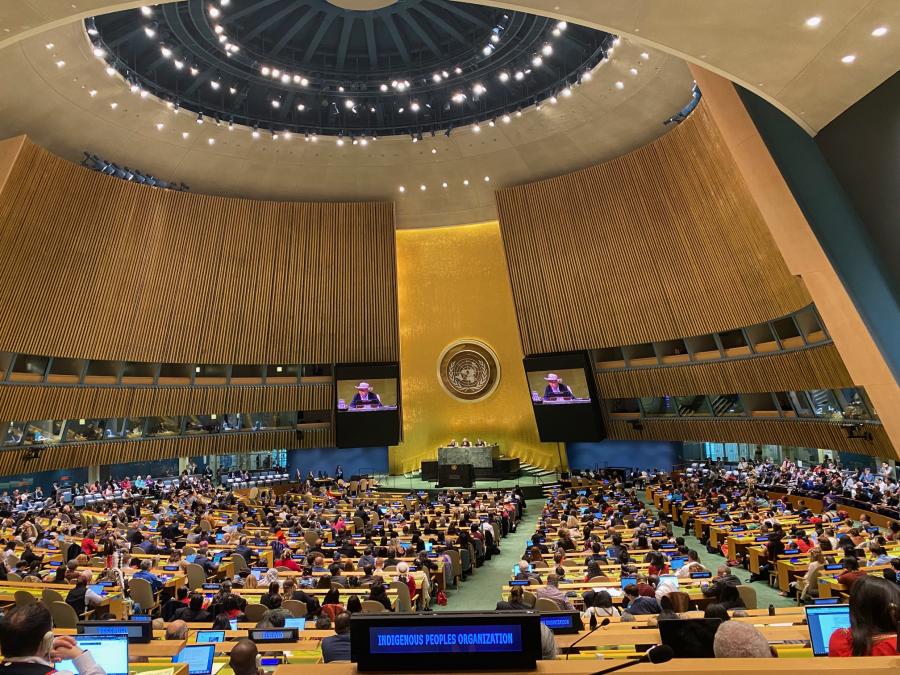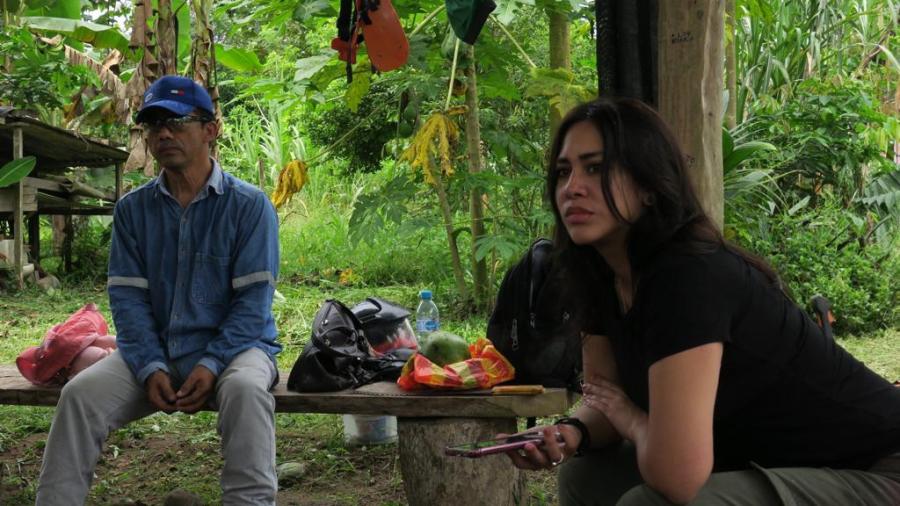New York: Clarkson N. Potter, Inc., 1997. $45 (cloth) ISBN 0-517-70368-8
Like most Americans of my generation, I grew up with the television. My family was the first on the block to acquire a small "black and white," and suddenly I had more friends than I knew what to do with. Besides providing a lesson in basic sociology, the television was a mesmerizing window to the world. I remember most fondly the travelogues -- in particular the travels of Lowell Thomas. Each week Lowell took us along as he journeyed up uncharted rivers and across unmapped mountains, often visiting remote villages along the way Sometimes native peoples emerged from dense jungles along the riverbanks, then suddenly disappeared -- allowing us only the briefest of glimpses. Needless to say, I was glued to the set.
I hoped someday that I would be able to follow in Lowell's footsteps and travel to some of those exotic lands. Over three decades later, I have traveled far and frequently, visiting forty-six countries and seven continents.
In 1992, I was one of two principal photographers for a book supported by the United Nations and published by the Sierra Club entitled Endangered Peoples. The author, Art Davidson, addressed many issues confronting indigenous peoples throughout the world. He detailed how political indifference, land loss, and the lure of modern technology had combined to undermine the cultural integrity on many indigenous cultures.
While I traveled and photographed for Endangered Peoples, journeying into the highlands of New Guinea, across the savannas of Africa, and up the tributaries of the Amazon, I was intrigued by the spectacular varieties and yet uncanny similarities of the people I encountered. Specifically, I was drawn to the elaborate body adornment and ceremonial dress that these cultures have developed over untold millennia. Feathers, skins, leaves, bones, and natural pigments decorate the human form in such an elaborate manner that they rival the most sophisticated couturiers. This flamboyant style and unparalleled pageantry became the inspiration for Tribes.
Body adornment as a subject for a book is hardly my own invention. I am forever indebted to Malcolm Kirk, whose Man as Art is a stunning record of New Guinea's Highland tribes, and Angela Fisher for her unsurpassed work in Africa Adorned and Carol Beckwith, who collaborated with Fisher on the magnificent portrayal of Africa's indigenous culture in African Ark. Tribes is both a tribute to their work and a testament to the diversity of mankind.
Once I made the decision to devote myself to Tribes, I have to narrow the photographic approach, as I could be easily distracted by other aspects of tribal life. In order to maintain a coherent interpretation of the people I photographed, I decided upon a strictly aesthetic point of view, and settled upon three distinct perspectives. The first was the proverbial big picture: using wide angle lenses allowed me to take in ceremonial dances, promenades, and the individual within a landscape. The second was the macro view: getting up dose and personal to detail ear-piercing, tattoos, and scarification. The third was the mid-range telephoto, decidedly the most useful and pleasing perspective.
It has often been said that the eyes are the windows to the soul. Certainly they are the first thing we notice when we meet someone, and often they become the barometer to which they respond. Eyes can frighten, comfort, and hypnotize. From a confusion of color and texture, the eyes leap forward to stare straight into those of the viewer. The connection is both immediate and, at times, quite unnerving.
The 80-200 mm zoom lens truly defines Tribes. By narrowing in on a face, I was not only able to eliminate distracting elements, but I could accentuate the power and the dignity of the subject. the subject's eyes often provide an unsettling challenge to the viewer, offering an intense truth in the gaze and therefore leading to a more compelling image. This approach seemed exceptionally appropriate for Tribes. While most photographers ascribe to the theory that candid portraits are best, I decided upon a different tack because I wanted to heighten the tension between the subject and viewer. I deliberately sought the "in your face" approach.
The consistency with which I used the telephoto perspective has allowed me to present these different peoples in a more balanced way By concentrating upon body adornment, I was able to highlight an individual's pride and dignity regardless of personal wealth or social stature. Acreage, houses, and possessions are not what Tribes is about. It is about equality and continuity and diversity. Tribes allows the viewer to fully appreciate the keen sense of self as well as place that indigenous people truly have.
It was surprising to me that some of the tribes that had the least wealth displayed some of the most impressive adornment. The Kayapo, living in Brazil's Amazon Basin, have very little accumulated wealth. As hunter-gatherers and limited agriculturists, they must periodically relocate village sites in search of more productive areas. Since their largest domesticated animals are small dogs, they carry all their possessions themselves. The accumulation of personal objects, therefore, is not very prudent.
On ceremonial occasions, the Kayapo undergo an amazing transformation. They don headdresses of brilliantly hued macaw feathers and paint themselves in remarkable patterns with a startling red vegetable dye and sooty charcoal. The effect is dazzling, but equally important, they are not weighed down by elaborate costumes and cosmetic cases.
The Karo tribe inhabiting the remote, arid lands of southwestern Ethiopia also have very little accumulated wealth other than their herds. They too are often on the move, seeking better pasture for their cattle and goats. At first glance their grass huts, clustered upon the harsh, unforgiving landscape, would not be associated immediately with a decorative lifestyle. Yet the Karo are an extremely colorful people. Both men and women have wonderfully crafted hairstyles, replete with feathers, beads, and woven grasses. Ears are heavily pierced while arras and legs support many metal bands. On special occasions the entire tribe will paint themselves in beautiful designs using red, black, and white pigments made from local minerals. The Karo are indeed rich in cultural tradition.
While the Karo and Kayapo represent cultures that have remained for the most part both isolated and intact for countless generations, others have been absorbed into Western culture. The difficulty has been for these tribes, such as the Native American and Aboriginal, to maintain cultural traditions while leading modern lives.
It is important to understand that all the tribes portrayed in this book are our contemporaries, and like us, they have the ability to adapt, to succeed, and to fail, just as we do. The notion that isolating these peoples so that they will maintain their traditions in a pristine environment is a hopelessly romantic one. No place on earth is safe from the outside, and tribal peoples themselves hardly wish to be mired in a time warp. What they want most is to be able to adjust their lives in a manner most fitting with their traditions, yet be a part of the modern world.
In an era of accelerated change and penetration into remote areas by an aggressive, industrialized world, it is inevitable that many of these cultures will lose their uniqueness, slipping into oblivion. Although Tribes touches on some of the problems confronting these peoples, I do not attempt to present it as an indictment of political and environmental degradation. Instead I aspire to document the triumph of spirit and creativity of mankind.
As I reflect upon all the miles and destinations behind me, this indelible image stands out. Deep in the Xingu Indian Park of Brazil dwell the Kamayura. Their village is near the park's headquarters, where I set up a tent. One night as I prepared for bed, I noticed a bluish light reflecting upon the rainforest trees shadowing the buildings. Upon closer inspection I discovered that the light's source was a small black and white television hooked up to a generator. Half a dozen Kamayura children were peering through the screened window, watching a Brazilian soap opera. Needless to say, they were glued to the set. The moment was startling, the irony haunting.
Article copyright Cultural Survival, Inc.



